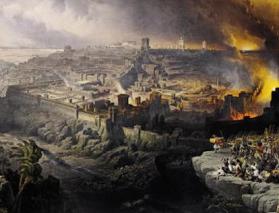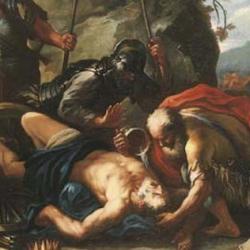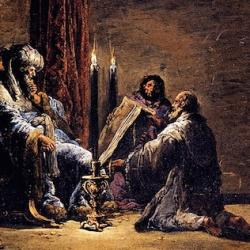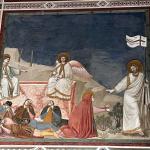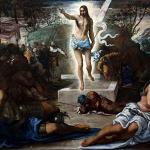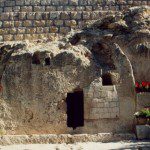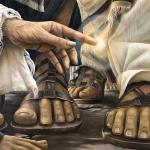David is the hyperactive organizer of the effort to bring the ark into Jerusalem. After the first attempt ended in Uzza’s death, David determines that they had violated the ordinance, the word of God through Moses (1 Chronicles 15:13, 15). He makes sure they don’t make the same mistake.
David prepares a place for the ark (15:1; 16:1). David declares that only Levites can bear the ark (15:2). David assembles Israel (15:3)> David summons priests and Levites (15:4). David instructs priests and Levites about their duties, and they obey (15:11-15). David tells Levitical princes to appoint musicians (15:15). David, with elders and captains, brings the ark (15:25). David leaps before the ark (15:29). David leads the offering of ascension and peace offerings (16:2). David blesses the people (16:2). David apportions bread and raisins to Israel (16:3). David appoints Levites and priests as permanent ministers before the ark (16:4). David leaves Asaph and his brothers in charge of the ark (16:37). David returns home to bless his own house (16:43). David, David, David – it’s all David. He doesn’t work alone, but he initiates nearly everything.
David doesn’t construct the temple, but he constructs the priests and Levites around the ark as a human house of God.
To details. David gathers 8 chiefs of 7 clans of priests and Levites: sons of Aaron (Zadok and Abiathar), Uriel of Kohath, Asaiah of Merari, Joel of Gershom, Shemaiah of Elizaphan, Eliel of Hebron, and Amminadab of Uzziel (15:4-11). The last three groups are subdivisions of the clan of Koath, which is responsible for the transport of the ark according to the book of Numbers. The total number of Levites involved is 862, the gematria of tabniyt, the word for “pattern” in tabernacle and temple texts (cf. Exodus 25:9, 40). The priests form the pattern for the house.
David instructs these “heads” (ro’sh) to consecrated themselves to bear the ark; the ark rides on the shoulders (v. 15) of the consecrated heads of Israel. They are going to carry the ark “according to the ordinance” this time, as Moses commanded. They will “bring up” the ark. The verb is ‘alah, “ascend”; the throne of God ascends to its place on the shoulders of holy priests, functionally angels who hold up the throne. The ark also ascends through the cloud of sacrificial smoke (15:26), also through an aural cloud of sacrificial song (15:16-24). Yahweh ascends as the Levites “lift up (rum) a voice of joy” (15:16).
David organizes the Levites to form this path of song. The text is a complicated, repetitive list, but has an order to it, three sections punctuated by references to gatekeepers (see an earlier, complementary analysis here):
1. 3 leading singers, 14 secondary musicians, gatekeepers (15:17-18).
2. 3 cymbal players, 8 harpists, 6 players of lyres, Chenaniah the prince, gatekeepers (15:29-23).
3. 7 priests with trumpets, gatekeepers (15:24).
There are 17 names in the original list, and 17 is the gematria of kabod, “glory.” Yahweh is enthroned within His radiant glory; now He comes to be enthroned in the musical glory of Israel. When the seven priests are added, we have 24, and a “chief,” Chenaniah. That anticipates the eventual structure of the priesthood, with its 24 clans and single high priest. It also anticipates the organization of the Levitical singers into a permanent structure of 24 groups.
Chenaniah’s (“Yah is gracious”) role is puzzling. He is a prince (sar) of the Levites who is skillful and gives direction in massa’. In Torah, the word is typically used to refer to the physical labor of transporting/bearing the tabernacle, but in 1 Chronicles 15 it appears to have something to do with music. It’s best to take this as one of a number of instances where priestly and Levitical terms take on new meanings, the physical bearing of the ark transformed into the work of “bearing up” Yahweh’s throne in song.
Once the ark is securely in Jerusalem, David appoints a permanent set of musicians. Ten are named as musicians under the leadership of Asaph (16:5), and then the Chronicler informs us that Asaph played cymbals and the priests blew trumpets (v. 6). Lyres and harps drop out for the moment, and the music reduces to brass and percussion, without strings. That makes a total of 12 musicians, gathered to “yudah”—to give praise to Yahweh (v. 7). The musicians are eventually split into two groups, those who remain in Jerusalem to serve the ark (16:37-38) and the priests and Levitical musicians who serve the Mosaic tabernacle at Gibeon (16:39-43). That double house of music will eventually become one in Solomon’s temple. But David has proven himself a good shepherd by constructing a holy house of musicians, a place for Yahweh’s throne filled with the glory of song, a refreshing pasture for the sheep.






